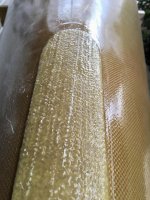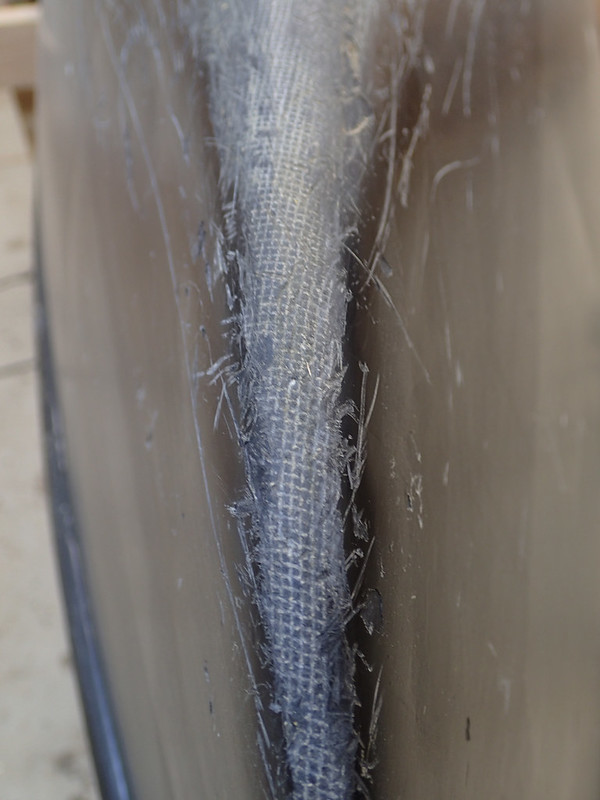And plus I think kevlar felt is the wrong material for the application in most case!
I tried polar fleece last year for a client and so far so good.... I also did a bunch of skid plates for an outfitter friend of mine out of multiple layers of S glass... seems to old up ok
At least there is a general consensus that kevlar felt is a poor choice in material for skid plates. My guess is that it was (still is) included in skid plate kits because it doesn’t fray at the edges during application and kinda sorta conforms to simple curves, so even folks who have never done and epoxy and cloth work could install a skid plate of rudimentary sorts.
Why some manufacturers continue to offer kevlar felt skid plates as a ($100) factory installed option is a mystery. Ugly factory installed kevlar felt skid plates, not even pigmented. Come on guys, y’all know how to work with cloth and epoxy. Why still kevlar felt?
It's true that Kevlar fuzzed when sanded, but I discovered by experiment (wanting to smooth that fresh plate) that it can be milled down with a farrier's file, without leaving any fuzz. Be very careful around the edges!
It seems to me that it's the epoxy in the matrix that provides the abrasion resistance, more than the fabric.
In some kevlar felt skid plate kits I believe that the epoxy does add substantially to the abrasion resistance.
Some skid plate kits; once upon a time most skid plate kits came with uber-stanky thick viscous urethane resin, which was tough stuff and probably shown to cause cancer in California. Today most kits (@ $100) come with what seems to be regular epoxy resin. Except for Old Town’s skid plate kits. See Goonstroke’s comment and link, and the
$300 MSRP.
On DIY’ed Dynel skid plates I have been using a 50/50 mix of regular epoxy (West 105/206) and 650 G/flex. In odor and viscosity G/flex seems a lot like OT’s urethane resin, and on vinyl skinned Royalex using some sticks-to-anything G/flex in the mix can only help. On a poly hull I would use straight G/flex, and flame treat the surface first.
As in Steve’s technique I filed down the abrupt edge of a poorly installed felt skid plate on a friend’s Appalachian. An extraordinarily tall, abrupt and gurgly edge; he had used every ounce of skid plate epoxy in the kit, every kit I ever used (regret every one) came with way more epoxy than needed, and he continued to lay it on as it began to thicken in the pot.
 P5260024
P5260024 by
Mike McCrea, on Flickr
A better solution - not that anyone should ever install a kevlar felt skid plate - is to wait until the epoxy has begun to set up and then use a tongue depressor to push down along the tall standing edges of the felt. The epoxy saturated felt will bevel down along the edges and hold that compressed shape. With the edges faired down it won’t gurgle as badly, and will be less likely to catch an abrupt skid plate edge on a rock and bust off chunks.
About skid plate material compression, any material will lie smoother and more flush if compressed under release treated peel ply. Someone on this board once remarked that Dynel “Swells like an old sweatshirt” with epoxy application. It does, but compressed under peel ply, by hand or hard roller, it practically vanishes in thickness and is still as abrasion resistant. Even multi-layer skid plates dang near disappear when peel ply hard roller compressed as the epoxy sets up.
I don’t know if peel ply compression works with polyester sweatshirt material or Polar Fleece, but photos of similar uncompressed materials lead me to believe that peel ply application would be a good idea on those thick swelled materials as well.
It doesn't take long to sand away epoxy. It takes very little extra time to sand away epoxy+carbon. It takes longer to sand away epoxy+E-glass. It takes longer than that to sand away epoxy+S-glass. I'm not quite sure how long it takes to sand away epoxy+dynel because I've always given up before I got that far.
Alan, yup. Exactly as demonstrated in the experimental skid plate materials impact and abrasion tests. And as demonstrated in the real world on three sea kayak that are client-used/abused in the most abrasive environment, Everglades trips involving limestone, worm rock and oyster bars. One kayak done with E-glass, one with S-glass, one with Dynel.
The E-glass and S-glass didn’t last a single season, the Dynel kept on going.
What is most interesting to me is that some paddlers, who I believe actually use their boats a lot, do not need skid plates for decades, and other’s need a skid plate within a year or two. Or, like Alan, in three weeks time.
I don’t think it is necessarily bad boating habits; different trips and locales and environments play a part. A couple of our decked canoes are used almost entirely on shallow sand-bottomed bays. So shallow that grounding out the boat in 3” of water passing over an extensive sandbar is pushing/wading/dragging routine. No limestone, no worm rock and dang few shells, mostly just coarse sand. Even that minor but frequent abrasion wore away at the stems.
Another reason to wait to see where the abrasion wear areas occur; our more blunt stemmed Royalex canoe showed abrasion wear over a wider but sometimes shorter area. Those skid plates were installed, an inch or two beyond the demonstrated high wear areas, as need. Some on blunt stemmed RX hulls were short and fat.
 PB180020
PB180020 by
Mike McCrea, on Flickr
And some were longer and skinnier
 PB180015
PB180015 by
Mike McCrea, on Flickr
Canoes have different stem shapes, and one size does not fit all.
Our sharp vee stemmed decked canoes that suffer coarse sand abraded stems needed only a couple inch wide strip, but three feet long.
 PB180018
PB180018 by
Mike McCrea, on Flickr
Gawd bless Dynel sleeve for that application. Several of the aforementioned client abused sea kayaks have full length vee bottoms. Extremely worn vee bottoms, they will soon be getting a full keel length run of Dynel sleeve, compressed under peel ply. Still wish I could find peel ply
tape; rolls of pre-cut 3 or 4 inch wide peel ply.
Yeah, yeah, too many dang words. I estimate I have installed 50 or 60 skid plates, including (I regret every one) kevlar felt, E-glass, multi-layer S-glass, thick kevlar tape, thick bias woven Twaron tape, Dynel fabric and Dynel sleeve. I believe in the value of a proper size/shape/material skid plate, and remain fascinated by best-practice skid plate application.
The best, or at least funnest, of the kevlar felt skid plates came at the end of (for me) that era. We put skid plate kits on two canoes owned by a pair of paddling sisters, Patty and Theresa, aka (self named) “The Squatters”. They bought two OT skid plate kits and brought their boats up to the shop. They were most delightful shop partners, and quick to pick up “Watch me do one, help with one, do the rest on your own while I watch” shop practices.
As we were finishing up in the shop Patty mentioned how she “Likes bright shiny things”. I handed her a vial of gold glitter and she sprinkled it over the still wet epoxy on both her and her sister’s canoes.
Their concocted story, if anyone noticed their flashy skid plates, was to exclaim surprise and mention, in an offhand way, that they had recently been paddling Yukon rivers that ran through old gold mine claims.















